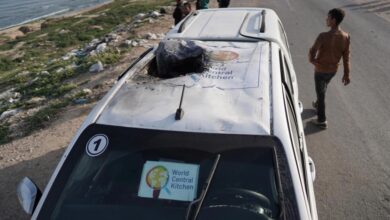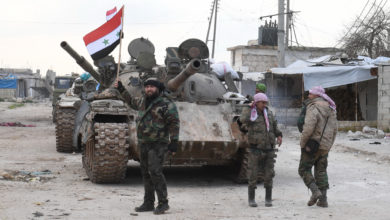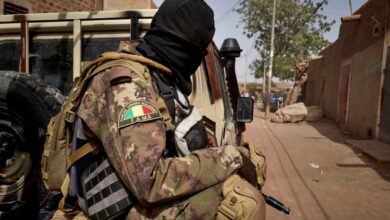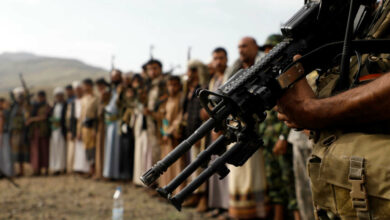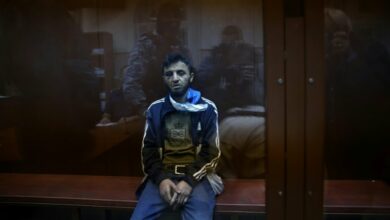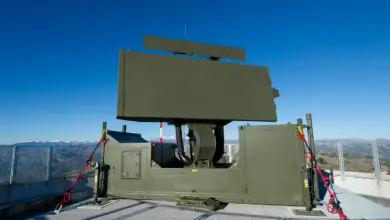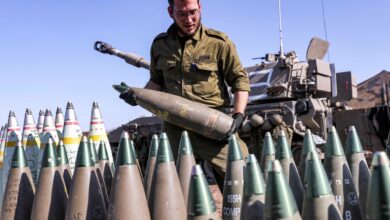
In June 2014, the Iraqi Armed Forces were demoralized: the country’s second largest city, Mosul had fallen into the hands of Islamic State without any significant fight.
“We can’t beat them. We can’t. They are well trained in street fighting and we’re not. We need a whole army to drive them out of Mosul,” an Iraqi officer told Reuters at the time. “They’re like ghosts: they appear to strike and disappear in seconds.”
Three years and more than 13,300 Coalition strikes later, ISIS has lost every major stronghold it once controlled in Iraq.
The battle to reclaim Mosul that lasted nine months and four days has become described as the most complex urban operation since World War II. The Iraqi officer who thought the terror group could not be stopped, was proven wrong: the days of ISIS’s physical “caliphate” are all but over. Pockets of leftover fighters continue to be cleared from Iraq every day.

Brigadier General Andrew Croft, the deputy air commander of the anti-ISIS Coalition’s land component, said in October that if Iraq had the forces it has now, with the capabilities they now have, ISIS could have been destroyed once it first appeared “within probably a week.”
Croft spoke to The Defense Post about the progress the Iraqi forces have made and the next stage of operations to clear Iraq of the remnants of ISIS.
New ISF capabilities
Since 2014, the U.S.-led Coalition has trained some 106,000 Iraqi Security Forces. The ISF have built confidence and become more cohesive, learning to operate in a much more coordinated fashion.
“They are much faster to operate and attack. They have the advantage of some coalition enabling forces, which would be the ability to find the enemy, find ISIS, using our surveillance and reconnaissance, and now they are able to use their surveillance and reconnaissance,” Croft said.

At present, Iraq has the aircraft and drones necessary to conduct such operations, as well as a viable helicopter force. The Iraqi military’s ability to synchronize and coordinate the forces has allowed them to act much more quickly.
In addition, the Iraqis have developed the ability to conduct precision strikes with their F-16 fighter-bomber aircraft. Croft noted that these capabilities came to maturity in the past three years.
“If you had a force like ISIS … [moving] towards the city of Mosul, it would allow them to react and attack in a way now that they were not able to do three years ago,” he added.
The U.S. and Coalition advisers have been working on building the Iraqis’ capability to do all operations on their own. “They can do it right now. It is just to what degree or what level,” Croft said.
The general explained that the Iraqi military has the capability to do surveillance, reconnaissance and precision strikes to take remnants of ISIS out of the field. He noted, however, that it is something that needs to continue to be developed with assistance from the Coalition advisers and training.
“That’s what the long-term goal here is, so that we can maintain the capability in this country to defeat an ISIS-like threat when it first appears and get after it with the security forces that exist right now. And that includes the local security as well,” Croft said.
Lessons from the Mosul battle
Every battle fought by the Iraqi military has become a learning experience. Even the beginning of the Mosul offensive was different from its end.
It was in Mosul that the Iraqi army, federal police and special forces had to cooperate in an urban environment for the first time. Acting independently resulted in setbacks and losses, and the importance of coordination came to the fore.

Croft said the Iraqi military’s latest victories in Tal Afar and Hawija and in Anbar province have demonstrated their ability to come up with a coordinated attack plan more quickly compared to Mosul.
The general noted that in the last three offensives, the Iraqis had dates set for starting operations and they were never changed.
“Early on in Mosul fights, even in the middle of Mosul fights, the ability to actually start another attack would get delayed sometimes, and that has not been the case recently,” Croft said.
The general noted that for the Iraqi military to be able to advance their targeting capabilities further, they need even more surveillance and reconnaissance assets, like unmanned aerial vehicles, and the communication architecture to link them to command centers throughout Iraq, which are then linked to air and ground forces.
“The more that develops, the more the fight against an enemy similar to ISIS can be done more quickly,” Croft said.
Precision strikes near Al Qaim
Precision strikes require precision intelligence and the Iraqi military has been able to improve this aspect of their operations as well. In the last two months, the Iraqi Air Force carried out strikes near Al Qaim, allowing ground forces to move into the city.
“They were doing precision strikes for at least a month or two before that to eliminate ISIS command and control nodes, or networks,” Croft said. “They were able to identify where ISIS fighters were located and do those precision strikes. They were not really able to do that as well just about four or five months ago.”
According to the general’s estimates, in the last four months the Iraqis have carried out about 150-200 precision strikes using fighter-bomber aircraft.
“Their strikes also include their Army Aviation command. They have the ability to carry out strikes with their helicopters as well,” Croft noted.

The Iraqi military has become particularly good at “deliberate shaping operations” conducted in preparation for a battle and have demonstrated the ability to rapidly advance into the heart of a city like Al Qaim, which was liberated “a little more quickly” than was anticipated, Croft said.
“Once they start moving, they keep moving. And I think that is another lesson that has been learned over time: if they remain static it is much harder to defeat the enemy,” he added. “Doing the preparation with precision strikes is another thing they have done well.”
With the capture of Al Qaim on November 3, the ISF have essentially sealed off the border with Syria.
Last Thursday, the Syrian regime forces announced that they retook from ISIS the city of Bukamal, located close to the border with Iraq. Nevertheless, many have disputed the claim that Al Bukamal is fully under government control.
As strikes in the area continue, Croft said he had seen no evidence that Iraqi military intends to cross the border into Syria.
He noted, however, that “the government of Iraq, if they need to do so, will not allow ISIS to have a sanctuary and then be able to attack from across the border, which is essentially just a line drawn between two cities.”
“What the government of Iraq does, will be in their own best interest, but right now I haven’t seen any elements of the Iraqi air forces crossing that border. But we do that as a coalition, as the air component,” he concluded.

Effective Iraqi air power
Iraq is expected to have a total fleet of 35 F-16s within several years. To date, 20 jets have been delivered, and the Iraqis have used them effectively.
“The key is to have an effective, affordable and sustainable capability. That does not only mean more stuff or more weapons. What it means is the weapons you have, you are able to do adequate training, you are able to maintain and sustain those weapons systems, and then use them effectively,” Croft said.
He explained that Iraqi Air Force F-16s carry between two and four bombs on every mission, each one with precision strike capabilities.
“So if you launch just two F-16s, they can hit up to eight precision targets in just one strike, which is a game changer as far as capabilities,” Croft said.
“If they know ISIS has leaders or commanders in a certain house, they can strike this house with just one bomb, and they have demonstrated this capability over and over again. So in this case, larger numbers [of aircraft] is not necessarily always better,” he added.
In May, Iraq had 14 F-16 pilots, with at least 26 others in various stages of training.
Croft said there are people in training at all times, as the program for F-16 pilots takes up to three years to complete. It includes a year of pilot training, half a year of English language training and about another year to go through fighter training.
“About every four to six months another group of two, three or four pilots appears out of the training system and then goes to the F-16 squadron in Balad [Air Base],” he noted.

The number of missions flown by the Iraqi pilots on a daily basis varies depending on the conditions on the ground.
“If you are in a sustained fight, maybe like Al Qaim was, in the last two months or the last month, they would do between two and eight strikes a day, depending on what kind of target they have,” Croft said.
The Iraqi pilots primarily fly during the day, but they have done some night strikes as well. However, they are yet to try their skills in conducting close air support missions. Croft said the Coalition is working with the Iraqis to train their forward air controllers who coordinate between the ground force and the pilots that drop bombs.
“That training is actually ongoing. That is, again, part of our advise-and-assist mission here, to build more and more of that training,” he added.
About 20 people have been trained so far to call in airstrikes on behalf of the ground forces. Croft said they have done well, but the close air support capability was not used in the last couple of fights.
“That is what you would use in a larger battle, if you have to fight a conventional enemy on the battlefield. So the requirement to do that may not be immediate … because what they are going to need to do now in the next phase of security and stability is to pluck out those individual enemy that may appear like in ISIS-type threat, but it won’t be on large scale, so they wont necessarily need that close air support,” he added.

A new phase in anti-ISIS operations
As ISIS lost all its major strongholds in Iraq, the focus of military operations has started to shift toward surveillance and reconnaissance.
The number of Coalition strikes has dropped by 60-70 percent lately.
“That will continue to be reduced over time to potentially near zero,” Croft said. “We will still maintain capability in the theater to react if we have to, but what it means is, the demand on surveillance and reconnaissance assets will remain relatively static. It is not going to drop off quite a bit.”
The general noted that although the physical “caliphate” may be gone, there is still a threat to security and stability in small pockets throughout Iraq and Syria, where remnants of ISIS require surveillance and reconnaissance.
“So we are going to maintain that capability here probably commeasured with the threat,” Croft said.
The composition of U.S. personnel deployed to Iraq may change, with some drop in the military side and a commeasured decrease of civilians, such as contractors.
Croft said, however, that ultimately it would be the need to ensure certain capabilities and provide training that will determine the numbers of U.S. personnel that remain in Iraq.
“What we don’t want to do is drive the number and then try and fit a capability inside of a number, so the number is not a measure of success. The measure of success is the capability, capacity and training, and building a professional force, consolidating our gains. Those things will drive the number that remains,” he said.
The Iraqi military training has proven to be a success story and the experience can be used in other theaters, like Afghanistan, according to Croft.
“The training of the Afghanistan Air Force and the introduction of the A-29 Super Tucano attacker plane is an outright success story. The Afghanistan Air Force, which actually has been built from ground up, and now it gives them the capability to do also precision strikes in a very difficult terrain,” he said. “So I think this model is equally usable in other areas of the world as well. The key is to build that capacity over time.”



